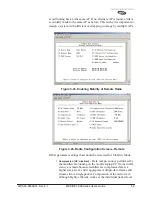
50
MDS iNET 900 Series User’s Guide
MDS 05-2806A01, Rev. E.1
•
Dwell Time
(Not applicable to iNET II)—Duration (in millisec-
onds) of one hop on a particular frequency in the hopping pat-
tern.
Dwell Time
should be set to 32.8 ms. (This field is only
changeable on an Access Point. Remotes get their value from
AP upon association.)
[
16.4, 32.8, 65.5, 131.1, 262.1; 32.8
]
TIP:
If a packet is being transmitted and the dwell time
expires, the packet will be completed before hopping to the next
frequency.
•
Beacon Period
(Not applicable to iNET II)—Amount of time
between Beacon transmissions (in msec).
Available Intervals:
Normal
(104 ms),
Fast
(52 ms),
Faster
(26
ms),
Slow
(508 ms),
Moderate
(208 ms). These values provide rel-
atively quick association times where Fast is very fast (
≈
5 sec)
and the other end, the largest recommended value, the 508 ms
period is slow (
≈
60 sec). [
Normal, Fast, Faster, Slow, Moderate; Nor-
mal
]
TIP:
Increasing the Beacon Period will provide a small
improvement in network data throughput. Shortening it
decreases the time needed for Remotes to associate with
the AP. A short beacon period is usually only a benefit
when there are mobile Remotes in the network.
•
Hop Pattern Seed
(AP Only; Not applicable to iNET II)
—A user-select-
able value to be added to the hop pattern formula. This is done
in the unlikely event that identical hop patterns are used with
two collocated or nearby networks. Changing the seed value
will minimize the potential for RF-signal collisions in these sit-
uations. (This field is only changeable on an Access Point.
Remotes read the AP’s value upon association.) [
0 to 255; 1
]
•
Fragment Threshold
—Before transmitting over the air, if a packet
exceeds this number of bytes, the transceiver sends the packet in
multiple fragments that are reassembled before being delivered
over the Ethernet interface at the receiving end. Only even num-
bers are acceptable entries for this parameter. Over-the-air data
fragmentation is not supported on AP units. (
See “Network Per-
formance Notes” on Page 87
for additional information.)
[
256–1600 bytes; 1600
]
TIP:
In an interference-free environment this value should be
large to maximize throughput. If interference exists then
the value should be set to smaller values. The smaller the
packet the less chance of it being interfered with at the cost
of slightly reduced throughput.
•
RTS Threshold
—Number of bytes for the over-the-air RTS/CTS
handshake boundary. (
See “Network Performance Notes” on
Page 87
.) [
0 to 1600 bytes; 500
]
Summary of Contents for iNET 900 Series
Page 10: ...2 MDS iNET 900 Series User s Guide MDS 05 2806A01 Rev E 1 ...
Page 26: ...18 MDS iNET 900 Series User s Guide MDS 05 2806A01 Rev E 1 ...
Page 118: ...110 MDS iNET 900 Series User s Guide MDS 05 2806A01 Rev E 1 ...
Page 120: ...112 MDS iNET 900 Series User s Guide MDS 05 2806A01 Rev E 1 ...
Page 136: ...128 MDS iNET 900 Series User s Guide MDS 05 2806A01 Rev E 1 ...
Page 148: ...140 MDS iNET 900 Series User s Guide MDS 05 2806A01 Rev E 1 ...
Page 150: ...142 MDS iNET 900 Series User s Guide MDS 05 2806A01 Rev E 1 ...
Page 164: ...156 MDS iNET 900 Series User s Guide MDS 05 2806A01 Rev E 1 ...
Page 172: ...164 MDS iNET 900 Series User s Guide MDS 05 2806A01 Rev E 1 ...















































